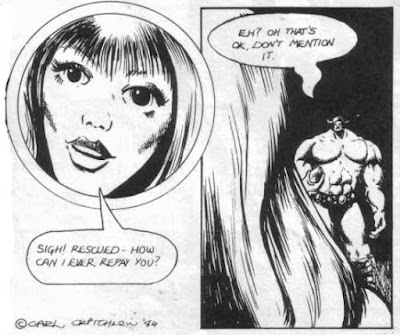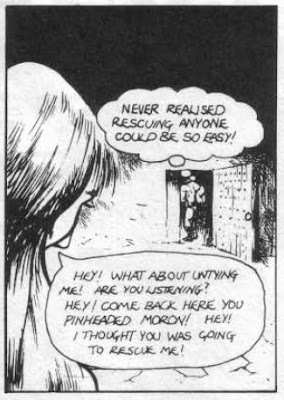James Maliszewski's Blog, page 94
November 6, 2022
Pulp Fantasy Library: The White Sybil
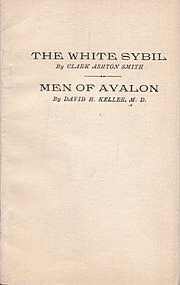 I am regularly struck by the industry demonstrated by the writers of the Golden Age of the Pulps. The sheer number of stories they collectively produced during the period between the two world wars is simply staggering. Despite the large number of professional, paying magazines actively soliciting submissions at the time, there was no way these periodicals could keep pace with the torrent of fiction being penned. For that reason, even established wordsmiths of the caliber of Clark Ashton Smith sometimes had to turn to amateur fanzines or limited run anthologies if they hoped to see some of their works to see print.
I am regularly struck by the industry demonstrated by the writers of the Golden Age of the Pulps. The sheer number of stories they collectively produced during the period between the two world wars is simply staggering. Despite the large number of professional, paying magazines actively soliciting submissions at the time, there was no way these periodicals could keep pace with the torrent of fiction being penned. For that reason, even established wordsmiths of the caliber of Clark Ashton Smith sometimes had to turn to amateur fanzines or limited run anthologies if they hoped to see some of their works to see print.Such was the case with Smith's "The White Sybil," completed in mid-1932 and reluctantly rejected by Farnsworth Wright, editor of Weird Tales, who considered it more a prose poem than a story proper. This was a common – and I daresay fair – criticism of many of Smith's submissions. He was by training and temperament a poet and even his best works of "pure" fiction nevertheless evince the incantatory rhythms of verse. For this reason, "The White Sybil" only saw print in 1935 as part of a limited (500-copy) anthology produced by William L. Crawford, the young science fiction fan behind Marvel Tales and Unusual Stories, two short-lived but important semi-pro periodicals.
"The White Sybil" tells of Tortha, himself a poet, who after having "wandered in the quest of that alien beauty which had always fled before him like the horizon," returns to his native city of Cerngoth in Hyperborea. During his travels, Tortha had "beheld many marvels," which is why he was surprised to behold an even stranger marvel while he wandered the streets of Cerngoth, namely, the fabled White Sybil of Polarion.
He knew not whence she had come, but suddenly she was before him in the throng. Amid the tawny girls of Cerngoth with their russet hair and blue-black eyes, she was like an apparition descended from the moon. Goddess, ghost or woman, he knew not which, she passed fleetly and was gone: a creature of snow and norland light, with eyes like moon-pervaded pools, and lips that were smitten with the same pallor as the brow and bosom. Her gown was of some filmy white fabric, pure and ethereal as her person.
In wonder that turned to startled rapture, Tortha gazed at the miraculous being, and sustained for a moment the strangely thrilling light of her chill eyes, in which he seemed to find an obscure recognition, such as a long-veiled divinity, appearing at last, would vouchsafe to her worshipper.
The White Sybil was a " mysterious being who was rumored to come and go as if by some preterhuman agency in the cities of Hyperborea." None knew her name or her origins, only that she often "utter[ed] cryptic prophecies and tidings of doom." Indeed, she had long ago pronounced the destruction of Hyperborea and its civilization and, for that reason, men feared her – except for Tortha.
In that single glimpse, he had found the personification of all the vague ideals and unfixed longings that had drawn him from land to land. Here was the eluding strangeness he had sought on alien breasts and waters, and beyond horizons of fire-vomiting mountains. Here was the veiled Star, whose name and luster he had never known. The moon-cold eyes of the Sybil had kindled a strange love in Tortha, to whom love had been, at most, no more than a passing agitation of the senses.
Overcome by "wild Uranian ecstasy," the poet determines to seek out the White Sybil by ascending a snow-capped mountain where he believed she could be found. The ascent was both physically and mentally arduous, yet he never once considered turning back, so great was the "unearthly fervor and exaltation" that she engendered in him. Eventually, he succeeds in finding the object of his quest.
With timid steps, with eyes that faltered before her mystic beauty, and a flaming as of blown torches in his heart, he entered the arbor. From the bank of blossoms on which she reclined, the Sybil rose to receive her worshipper. . . .
Of all that followed, much was forgotten afterwards by Tortha. It was like a light too radiant to be endured, a thought that eluded conception through surpassing strangeness. It was real beyond all that men deem reality: and yet it seemed to Tortha that he, the Sybil, and all that surrounded them, were part of an after-mirage on the deserts of time; that he was poised insecurely above life and death in some bright, fragile bower of dreams.
He thought that the Sybil greeted him in thrilling, mellifluous words of a tongue that he knew well, but had never heard. Her tones filled him with an ecstasy near to pain. He sat beside her on the faery bank, and she told him many things: divine, stupendous, perilous things; dire as the secret of life; sweet as the lore of oblivion; strange and immemorable as the lost knowledge of sleep. But she did not tell him her name, nor the secret of her essence; and still he knew not if she were ghost or woman, goddess or spirit.
The last paragraph is, I think, quite effective in the way it struggles to describe the painful, delightful, and contradictory human experience of beauty and the desire to somehow possess it, not to mention the equally human experience of being unable to do so, no matter how much we might wish it.
There are two endings to "The White Sibyl," the one published in Crawford's 1935 anthology and Smith's original ending, the former of which can be found via the link above and which offers a somewhat more hopeful conclusion to Tortha's sojourn. Much as I like the tale, neither version strikes me as the kind of thing that would likely have appealed to the typical reader of the Unique Magazine and I can hardly blame Wright for having rejected it. "The White Sybil" is not a weird tale as generally understood, but rather an extended meditation on longing and the futile lengths to which we will sometimes go in an attempt to sate it – hardly the stuff of rousing adventure but a worthy topic for introspection and one especially well suited to the talents of Clark Ashton Smith.
November 4, 2022
Born in Arizona, Moved to Babylonia
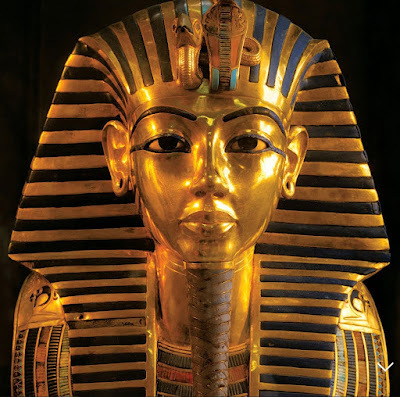 Today marks the centenary of Howard Carter's discovery of the tomb of Tutankhamun in the Valley of the Kings. I would have thought this would be more widely celebrated in mass media, given the status of King Tut in the popular culture of the last hundred years. Unless I've somehow managed to miss it, the coverage of this significant anniversary seems to be much more low-key than that which accompanied the "Tut-manias" of the 1920s and 1970s. For good or for ill, there don't appear to be so many trinkets, toys, T-shirts, and posters – or songs – this time around.
Today marks the centenary of Howard Carter's discovery of the tomb of Tutankhamun in the Valley of the Kings. I would have thought this would be more widely celebrated in mass media, given the status of King Tut in the popular culture of the last hundred years. Unless I've somehow managed to miss it, the coverage of this significant anniversary seems to be much more low-key than that which accompanied the "Tut-manias" of the 1920s and 1970s. For good or for ill, there don't appear to be so many trinkets, toys, T-shirts, and posters – or songs – this time around.More than a decade ago, there was an exhibition of artifacts from Tut's tomb and my family and I got the chance to see them while it was in town. Though the famous gold burial mask was not among the artifacts present, there were plenty of other remarkable items. Looking at them, even behind protective glass, is an amazing experience, especially if you're cognizant of just how old they are. I can only imagine what it must have been like for Carter, Lord Carnarvon, Lady Evelyn, and Arthur Callender to have first laid eyes upon them, the first people to have done so in more than 3000 years (aside from some grave robbers).
In his 1923 book with A.C. Mace, Carter described the experience of opening the tomb in this way:
At first I could see nothing, the hot air escaping from the chamber causing the candle flame to flicker, but presently, as my eyes grew accustomed to the light, details of the room within emerged slowly from the mist, strange animals, statues, and gold – everywhere the glint of gold.
This is some of what they saw:
 The photograph at the top is obviously the original, while the one at the bottom was colorized decades later. I included the colorized version in an attempt to convey some of the wonder Carter and company must have felt upon seeing the antechamber to the tomb and its grave goods. At the same time, the photos also convey a contradictory feeling, a recognition of just how ordinary the scene actually is. Certainly there are many gilt artifacts within but there are also an equal number of relatively mundane things, like unadorned chests, wooden shelves and furniture, and spare chariot wheels. If it weren't for their antiquity, they could almost be the contents of someone's garage rather than the treasures of a god-king from three millennia ago.
The photograph at the top is obviously the original, while the one at the bottom was colorized decades later. I included the colorized version in an attempt to convey some of the wonder Carter and company must have felt upon seeing the antechamber to the tomb and its grave goods. At the same time, the photos also convey a contradictory feeling, a recognition of just how ordinary the scene actually is. Certainly there are many gilt artifacts within but there are also an equal number of relatively mundane things, like unadorned chests, wooden shelves and furniture, and spare chariot wheels. If it weren't for their antiquity, they could almost be the contents of someone's garage rather than the treasures of a god-king from three millennia ago.I find this all weirdly comforting. Mind you, I get the same feeling when I look on photographs of people from the past, especially from the time shortly after the invention of photography. What sticks with me is the realization – or perhaps reminder is a better word – that people in the past were just people, little different from us, except in the most superficial of ways. They were no better or worse than we are today and I think we do ourselves and them a disservice by looking on the past as either a Golden Age the likes of which we shall never see again or a time of unique ignorance and viciousness that we have somehow transcended.
For me at least, Howard Carter's discovery of the tomb of Tutankhamun a century ago is a bit like those old photographs. It's a reminder that, while the past is a foreign country, that country was populated by human beings who, like us, probably gave little thought to the possibility that the world they knew would one day disappear into the mists of time – again, like us.
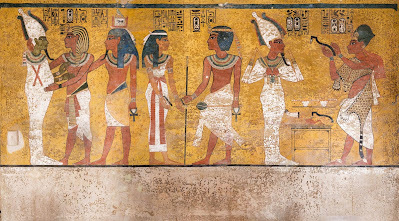
November 2, 2022
Retrospective: Cities of Hârn
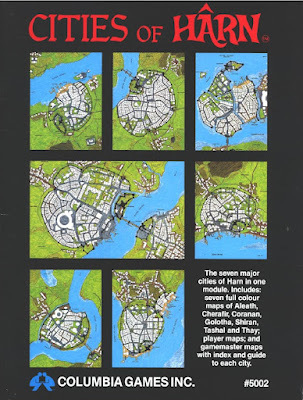 The issue of White Dwarf I discussed this week included a review of 1983's Cities of Hârn, the first major supplement for the Hârn fantasy setting published by Columbia Games. Written by Hârn's creator, the late N. Robin Crossby, Cities of Hârn is one of only a handful of Hârn materials I owned until relatively recently. I did so at least in part because of the ads I saw in the pages of Dragon, which highlighted its wonderful maps. I also did so because I find the mere idea of cities in a fantasy setting absolutely captivating. I blame Lankhmar.
The issue of White Dwarf I discussed this week included a review of 1983's Cities of Hârn, the first major supplement for the Hârn fantasy setting published by Columbia Games. Written by Hârn's creator, the late N. Robin Crossby, Cities of Hârn is one of only a handful of Hârn materials I owned until relatively recently. I did so at least in part because of the ads I saw in the pages of Dragon, which highlighted its wonderful maps. I also did so because I find the mere idea of cities in a fantasy setting absolutely captivating. I blame Lankhmar.Cities of Hârn begins with an overview of cities in general before offering up specific information on each of the seven cities of the setting. The overview focuses on the kinds of "realistic" details that are the hallmarks of Hârn's Anglo-Norman-inspired fantasy. There are discussions of guilds, markets, governments, and of course taxes and fees – lots of taxes and fees. I probably make this sound less appealing than it is, because most of these discussions are brief and add to the verisimilitude of the setting rather than getting bogged down in minutiae.
The real meat of Cities of Hârn lies in the sections that treat each of the seven major cities of the island of Hârn: Aleath, Cherafir, Coranan, Golotha, Shiran, Tashal, and Thay. Though there is some variation between the write-ups, each section follows the same pattern. There's information presented on each city's history, government, and economy, followed by two keyed maps of the entire city, one in color and one in black and white. In addition, each city includes a keyed map for a single important location within it. For example, the section on Aleath includes a map of The Sword & Sceptre, a three-story tavern, while the one on Shiran includes the Pamesani Arena. These location maps are quite useful, both because they provide the referee with a potential setting for a scenario or an encounter and because they offer some insight into the city in question. The aforementioned Arena highlights Shiran's role as "the pleasure capital of Hârn," where all manner of entertainment is available to those with the money to afford them.
The keyed maps are the main draw of Cities of Hârn. Though perhaps not as lovely as the large-scale maps included with the original Hârn, those in this product are still quite attractive, especially in their colored versions. More than that, they are useful, showing the locations of all the important places within a given city, as well as the area in the immediate vicinity of the city itself, such as rivers, roads, fortifications, and the like. Sometimes, extra detail is provided, like the sites of the underground tunnels beneath Tashal.
The map keys are of the same spare and utilitarian style that is typical of Hârn. The individual entries usually consist of only a line or two, with only the most important details given much space. The entries all include information on the number of typical inhabitants in a given building, the quality of the goods available there (if applicable), and their prices (again, if applicable). This is all presented in a system-neutral way, since the Hârn line was originally presented as a series of "generic" supplements for use with any fantasy roleplaying game system. Consequently, Cities of Hârn does require some work on the part of the referee to use effectively. Even leaving aside the matter of rules, there are many buildings and other locales in each city that are not keyed. Mind you, this leaves plenty of space for the referee to personalize the cities, which I consider a boon.
In the end, Cities of Hârn is, I think, pretty typical of the early Hârn products in being more like a "sketch" the referee is expected to fill in according to the needs of his own campaign rather than a fully fleshed out product ready to be used "out of the box." At the same time, its lovely maps and their keys are precisely what I wanted out of a product like this and more than justified the cost and relative difficulty it took to obtain a copy. Even though I never succeeded in running a Hârn-based campaign, I made good use of some of the maps in my own setting, which is about as high praise as I could have given a RPG product in those days.
November 1, 2022
Thrud to the Rescue
Secrets of sha-Arthan: Adept
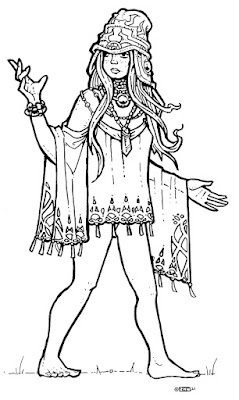 An adept by Zhu BajieHit Dice: 1d6
An adept by Zhu BajieHit Dice: 1d6Maximum Level: 14
Armor: Light or medium armor, no shields
Weapons: Any
Languages: Janeksa
An adept practices mental self-control to channel powers of the mind known as disciplines. The origin of this practice is shrouded in mystery, but it may be as ancient as the Makers themselves. Regardless of the truth, it is now widespread across sha-Arthan, particularly in those lands that were once part of the Empire of the Light of Kulvu.
CombatAn adept can use light or medium armor but does not have the training required to use heavy armor or shields. She can use any weapons.
DisciplinesAn adept uses her inherent psychic ability to activate a number of disciplines individually or in combination, according to the Adept Level Progression table below. Disciplines are chosen by the player from among the following:Clairvoyance: An adept can see through or into opaque or solid material within 30’ for up to 1 turn per level.Control Self: An adept exerts psychic control of her own body for 1 turn per level, during which time she can suspend normal bodily functions (stop or slow heartbeat, respiration, etc.) without a detriment to normal physical or mental performance; gain total recall of memory; or perform minor feats of strength, agility, and/or mental prowess. The referee has final say on the effects of these feats.ESP: By concentrating for 1 round, an adept can perceive and understand the thoughts of living creatures within 60’ for 1 turn per level. A target detects the adept’s use of this discipline with a successful WIL check. An unwilling target may make a mental attack save to resist. While reading thoughts, the adept may move but cannot attack.Fear: An adept can cause a target within 120’ to flee for 1 turn per level, unless it successfully makes a mental attack save.Healing Trance: By meditating intensely for 1 turn, during which time she is insensate and unable even to defend herself, the adept can heal herself 1d6+1 hit points per use. At 6th level, the trance heals 2d6+2 hit points per use. Alternately, the trance may be used to grant a +4 fortitude save bonus against one poison or disease per use.Illusion: An adept can create a visual illusion of her choosing so long as she concentrates. Within a range of 120’, an adept can animate an illusion within a 6’ cube +1’ per level. Targets who succeed at a mental attack save recognize the illusion for what it is. Illusory enemies have DR 10 and vanish if successfully struck. Damage dealt by such enemies is not real. A character who appears to die actually falls unconscious, a character petrified is paralyzed, and so on. Such effects last 1d4 turns.Mind Shield: An adept can shield her mind for 1 turn per level, granting her a +4 bonus to any saving throws against mental attacks of any kind for its duration. This discipline requires little concentration, so the adept is free to attack or use other disciplines while it is in effect.Mind Blast: An adept directs a blast of psychic energy at a target within 60’, dealing damage equal to 2d6 + 1 per level of the adept. A successful mental attack save halves the damage.Psychometry: The adept sees into the past of whatever single object she touches, understanding its function purpose, origins, and who has touched it in the last 10 years per level.Suggestion: An adept’s words take on a supernatural potency. Up to one HD of persons per level of the adept must make a successful mental attack save or follow her suggestion for 1 round per level of the adept. (If the suggestion would endanger a subject, that subject automatically saves). This discipline is language-dependent and may be used in conjunction with telepathy. The subject is unaware of the manipulation, but, after its duration, he realizes he has been psychically influenced. Suggestion may only be used once per turn against the same subject.Telekinesis: An adept can move solid objects with a remote psychic “hand.” The remote hand can be projected to a range of 20’ + 5’ per level and lasts for 3 rounds per level. The amount of weight manipulated is equal to 3 +1 per level VIG (see Encumbrance ). Movement speed is 10’ per round per level.Telepathy: An adept can establish bidirectional mental communication with one other living intelligent creature within 90’ for 1 turn per level. Every four levels, the adept can add another such creature to her mental communication. The creature need not share a language with the adept. Communication is limited to conscious thoughts but can include visual, auditory, tactile, and olfactory components.Frequency of UseTwice per day per level, an adept may use any combination of the disciplines she has developed. For example, a 2nd-level adept has developed three disciplines and may use any combination of them four times per day in total. For example, the adept could use ESP and suggestion once each and telepathy twice or ESP twice and suggestion and telepathy each once, or in any other combination.
Using DisciplinesAn adept must spend a round concentrating in order to activate a discipline. This precludes moving, attacking, or taking any other actions.
In combat: Like spell casting, using a discipline can be disrupted in combat (see Spell Casting ). The use of mental disciplines must be declared before initiative is rolled.
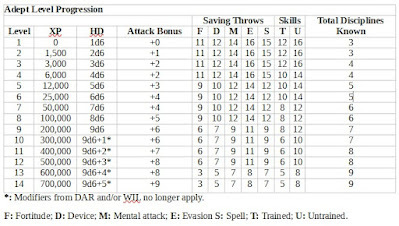
White Dwarf: Issue #56
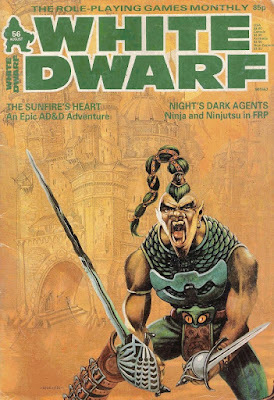 Issue #56 of White Dwarf (August 1984) features a cover by Chris Achilleos, who's probably most well-known for his contributions to Heavy Metal magazine. This particular illustration doesn't do much for me personally, but it's very much in keeping with the brash tone of the magazine during this time. In his editorial, Ian Livingstone sees a possible silver lining in the troubles of US game companies like TSR, namely, the emergence of "a thriving British RPG industry." Games Workshop certainly benefited from the decline of TSR in the mid-1980s; whether any other UK companies did so is an interesting question.
Issue #56 of White Dwarf (August 1984) features a cover by Chris Achilleos, who's probably most well-known for his contributions to Heavy Metal magazine. This particular illustration doesn't do much for me personally, but it's very much in keeping with the brash tone of the magazine during this time. In his editorial, Ian Livingstone sees a possible silver lining in the troubles of US game companies like TSR, namely, the emergence of "a thriving British RPG industry." Games Workshop certainly benefited from the decline of TSR in the mid-1980s; whether any other UK companies did so is an interesting question.
Speaking of the mid-1980s, what could be more appropriate than an article about ninjas? "Night's Dark Agents" by Chris Elliott and Richard Edwards is fairly typical of this surprisingly resilient genre of article. Rather than focus on how to include ninjas into any specific RPG, the authors instead talk about the reputed training, skills, weapons, and attire of ninjas in history and legend. It's fairly well done for what it is, but it's hardly groundbreaking in an era when nearly every gaming periodical published multiple periodicals of this sort.
"Open Box" reviews Games Workshop's "Battlebikes," giving it 7 out of 10. This game piqued my imagination at the time, but I never saw it in stores, let alone owned it. Also reviewed is "Turbofire" from Auto Ventures, a product and a company of which I've never heard. The product, which is given 8 out of 10, is apparently a multi-system adventure/campaign scenario designed for use with Car Wars, Battlecars, and Highway 2000 – how strange! Hârn, Cities of Hârn, and three installments of the Encyclopedia Hârnica are all reviewed together, collectively scoring 8 out of 10. The reviewer (Simon Farrell) speaks well of all the products; his main critique seems to be that, because they are presented in a system-neutral fashion, the referee will have to do a lot of work creating game stats for NPCs, monsters, etc. Finally, there's a review of Mayfair's The Forever War game, which garners a 7 out of 10.
For a change, Dave Langford's "Critical Mass" includes discussions of books I've actually read, like Donald Kingsbury's Geta (released in the USA under the title Courtship Rite, which is how I know it). It's a strange work of imaginary socio-anthropology about a colony of humans who survive on a hostile planet where only a handful of Earth plants can grow and whose diet must be supplemented by cannibalism. The book is better than it sounds! Langford also reviews Jack Vance's Lyonesse, which he likes less than The Dying Earth and its sequels, an opinion I share. Later in the column, Langford offers his opinions on the best, worst, most pretentious, and most sexist SF authors.
 It's an idiosyncratic list to be sure.
It's an idiosyncratic list to be sure.Since we're on the subject of bad writers, the next article is devoted to translating the fantasy novels of David Eddings into Dungeons & Dragons. Predictably entitled "The Belgariad," the article by Peter Ransome is thankfully short. Much more worthy of one's time is "The Last Log," a science fiction Call of Cthulhu adventure by Jon Sutherland, Steve Williams, and Tim Hall. Set in the early 23rd century, the scenario involves checking in with a corporate mining planet whose colonists haven't delivered any reports in over seven months. Naturally, something eldritch is afoot and it's up to the player characters to deal with it. I liked this adventure so much that I used a version of it in my college Traveller: 2300 with great success. Even now, I consider it one of the most original things ever published in the pages of White Dwarf.
"Mortal Combat" by Dave Morris is a collection of rules alterations and additions to the RuneQuest combat system. While I have no doubt that articles of this sort were of great interest to RQ fans, it was precisely this obsession with adding complexity to an already complex combat system that has long prevented my wholly embracing the game, which is a pity. Part 1 of "The Sunfire's Hart" by P.G. Emery is an excellent kick-off to an extended AD&D scenario for low-level characters. The initial premise is that the PCs are hired by the Guild of Sages to travel by boat a series of volcanic islands to find out why contact was lost with the last group to travel there – a common theme in many RPG scenarios, it would seem! The islands were once ruled by the defunct Solarian Empire, which maintained power through the use of an artifact called the Sunfire's Heart. The scenario involves not only discovering what happened to other inhabitants of the island but also the secret history of the Solarian Empire. It's far from a perfect adventure, particularly in terms of its presentation, but I am a sucker for adventures where ancient history plays a role.
"Plying the Spacelanes" by Paul Vernon is an alternate take on random starship encounters in Traveller. Vernon does a good job, I think, of expanding on and rationalizing the original tables without complicating them unnecessarily. The next time I referee a Traveller campaign, I might well make use of these. "To Boldly Go" by Joe Dever and Gary Chalk takes a look at sci-fi miniatures, including those produced by Grenadier for Traveller. "High Planes Drifters" is a collection of four D&D monsters from the planes beyond the Prime Material. As you'd expect, they're a mixed bag, with none of them really standing out as must-use additions to the game.
"Don't Touch That Dial!" by Phil Hine is an odd little article, in that it's ostensibly about the introduction of high technology into a D&D but is in reality simply about the introduction of two specific types of high technology: gunpowder and mechanical flight via ornithopters. The former is a perennial topic of interest to fantasy gamers, while the latter seems to stem largely from Moorcock's Runestaff series and Herbert's Dune. It's a mostly forgettable article, much like "The Psytron!" by Carol Hutchins, which reviews a 48K Spectrum game of the same name. I say that not because the game in question is a bad one – the reviewer gives it 9 out of 10 – but because it doesn't seem to have been a particularly successful or influential product. I'd much rather read the latest installments of "Thrud the Barbarian," "The Travellers," and "Gobbledigook," all of which I enjoyed more.
White Dwarf continues to trudge along solidly. At this point in its run, most issues were decent enough to hold my attention without much complaint and would often include one or two articles that I still remember even now. This is one of those issues, largely because of "The Last Log," which is a genuinely clever take on Call of Cthulhu. I look forward to seeing more like it in the issues to come.
October 30, 2022
Hallowe'en in a Suburb
And the trees have a silver glare;
Past the chimneys high see the vampires fly,
And the harpies of upper air,
That flutter and laugh and stare.
For the village dead to the moon outspread
Never shone in the sunset’s gleam,
But grew out of the deep that the dead years keep
Where the rivers of madness stream
Down the gulfs to a pit of dream.
A chill wind weaves thro’ the rows of sheaves
In the meadows that shimmer pale,
And comes to twine where the headstones shine
And the ghouls of the churchyard wail
For harvests that fly and fail.
Not a breath of the strange grey gods of change
That tore from the past its own
Can quicken this hour, when a spectral pow’r
Spreads sleep o’er the cosmic throne
And looses the vast unknown.
So here again stretch the vale and plain
That moons long-forgotten saw,
And the dead leap gay in the pallid ray,
Sprung out of the tomb’s black maw
To shake all the world with awe.
And all that the morn shall greet forlorn,
The ugliness and the pest
Of rows where thick rise the stones and brick,
Shall some day be with the rest,
And brood with the shades unblest.
Then wild in the dark let the lemurs bark,
And the leprous spires ascend;
For new and old alike in the fold
Of horror and death are penn’d,
For the hounds of Time to rend.
– H.P. Lovecraft
October 29, 2022
King-Emperor Trelu of Inba Iro
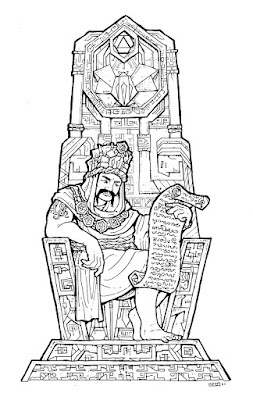 Trelu by Zhu BajieTrelu, known in Iromijan as Purushen (or "Devoted"), is the -great-great-grandson of Magdor and fifth Chomachto ruler of the Empire of Inba Iro. He inherited the Solar Throne of the First City while still a boy, with his mother Akatla and Hirano Chokan, the Great Royal Minister of the Right Side, acting as his regents. Trelu chafed under their guidance, which he saw as a repudiation of the policies of his father, Mabru, whose memory he revered. He also suspected that Hirano coveted the throne, if not for himself, then for an ambitious Ironian ally.Shortly after his formal accession, Trelu executed Hirano and exiled his mother to Ha'avya, where she died not long thereafter, a victim of the White Plague, it is said. He then began a bloody purge of any who had attempted to stymie his father's reforms of the court and the priesthoods. Within two years, Trelu was in firm control of both the First City and the Empire. Not even the normally restive kings of Eshkom and Miyajal dared oppose him.
Trelu by Zhu BajieTrelu, known in Iromijan as Purushen (or "Devoted"), is the -great-great-grandson of Magdor and fifth Chomachto ruler of the Empire of Inba Iro. He inherited the Solar Throne of the First City while still a boy, with his mother Akatla and Hirano Chokan, the Great Royal Minister of the Right Side, acting as his regents. Trelu chafed under their guidance, which he saw as a repudiation of the policies of his father, Mabru, whose memory he revered. He also suspected that Hirano coveted the throne, if not for himself, then for an ambitious Ironian ally.Shortly after his formal accession, Trelu executed Hirano and exiled his mother to Ha'avya, where she died not long thereafter, a victim of the White Plague, it is said. He then began a bloody purge of any who had attempted to stymie his father's reforms of the court and the priesthoods. Within two years, Trelu was in firm control of both the First City and the Empire. Not even the normally restive kings of Eshkom and Miyajal dared oppose him.So secure did Trelu believe his position to be that he devoted the first decade of his reign to the completion of his father's dream: a new capital for the Empire at Tamas Tzora. Once finished, he moved the court and scribes there. This unprecedented action did not sit well with the priesthoods, who reminded Trelu that he was emperor of the Twenty Cities only because he was king of da-Imer – and that required his physical presence within the First City. By upending tradition in this fashion, he was inviting calamity upon himself and his people. As he had before, Trelu responded harshly, stripping his critics of positions and privileges while elevating those who supported his efforts.
In the years since, the king-emperor has given himself over almost entirely to strengthening the reforms begun under his father and expanded by himself. This has earned Trelu many enemies, particularly among the ancient Ironian dynasties, some of whom have never really accepted the Chomachto as the rightful rulers of Inba Iro. Cabals against him grow and there are whispers of conspiracies to depose and replace him with a ruler more amenable to the old ways. Only the eternal gods know what the future holds.
October 28, 2022
Secrets of sha-Arthan: Study
Time and Cost
The time and cost necessary to learn a new skill depend on its complexity.
The table below assumes the character is involved in active study: at least eight hours each day during the required length of time devoted solely to study the skill he wishes to acquire. The days need not be consecutive, but the character cannot make a study roll until he has devoted one month (30 days) of 8-hour periods to the skill.
 Teachers The difficulty of finding a teacher is highly variable. Many of the larger cities of sha-Arthan (e.g. da-Imer or Chabaktechel) are home to one or more institutions of learning. Temples or philosophical academies are another source of teachers. Characters might also turn to any groups with which they are currently aligned (see Alignment). Finding an appropriate teacher could even form the basis of an adventure or extended series of adventures. Alternately, a character might choose to study on his own without a teacher. This option is available only for skills of Complexity 1 or 2. Self-study increases the time required and halves the cost. The values in parentheses on the table above are those for self-study.Study Rolls
Teachers The difficulty of finding a teacher is highly variable. Many of the larger cities of sha-Arthan (e.g. da-Imer or Chabaktechel) are home to one or more institutions of learning. Temples or philosophical academies are another source of teachers. Characters might also turn to any groups with which they are currently aligned (see Alignment). Finding an appropriate teacher could even form the basis of an adventure or extended series of adventures. Alternately, a character might choose to study on his own without a teacher. This option is available only for skills of Complexity 1 or 2. Self-study increases the time required and halves the cost. The values in parentheses on the table above are those for self-study.Study RollsAt the conclusion of every month of active study, the character must make a study roll. The study roll is the same as the character’s untrained skill save (see Skill Saves), modified by his Wits (see Ability Scores). If successful, the character advances in his study. Once a character has made successful study rolls for every month required of the skill he is studying, he has acquired the skill.
If unsuccessful, the character has learned nothing during the past month and must redo it (and the skill roll), provided he devotes the required time and money to the task. This process continues until either the character succeeds or he spends three consecutive months not engaged in active study (see Time and Money above), in which case he is considered to have abandoned study of the skill. He then loses all progress made up to this point and must restart the study of the skill from the beginning.
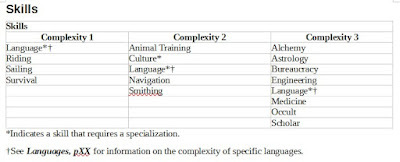
October 27, 2022
Grognard's Grimoire: Kijai
DR 11, HD 5* (22hp), Att 1 × touch (2d6), AB +4, MV 30' (10'), SV F12 D13 M14 E15 S16 (3), ML 12, XP 300, NA 1 (0), TT None
Immunity: Unharmed by all attacks except cold and fire.Division: Fulmination or attacks with weapons cause the kijai to divide into 1d4+1 2HD hijai that do half damage.Acid: After a successful attack, sticks to victim and exudes acid. The acid inflicts 2d6 damage per round to flesh and destroys cloth, leather, or wood in one round (stone and metal are unaffected).Seep: Can squeeze through small holes and cracks.
 A hijai by Zhu Bajie
A hijai by Zhu Bajie
James Maliszewski's Blog
- James Maliszewski's profile
- 3 followers


